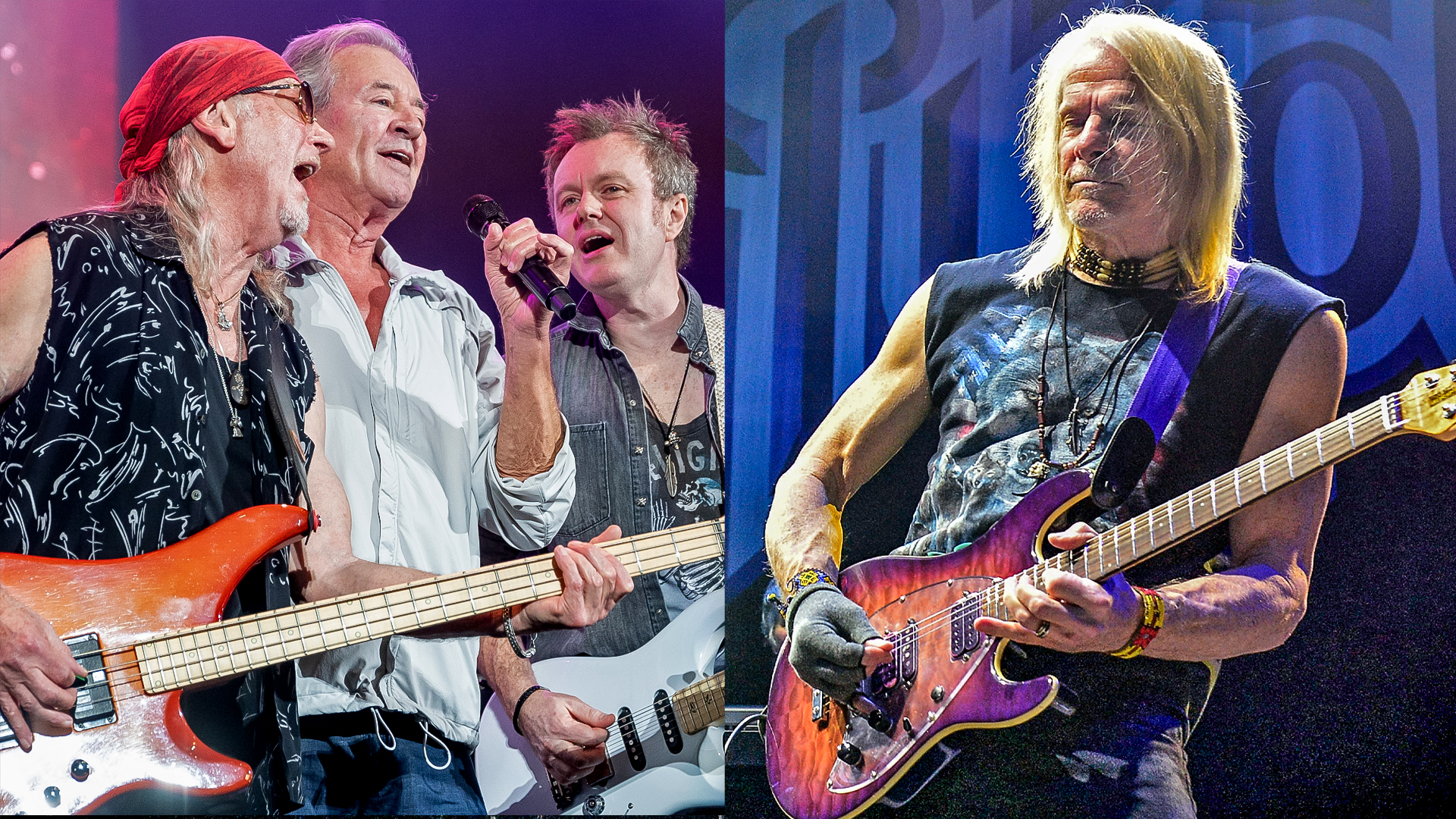“Every song on the radio had a killer solo. You knew you’d better come up with something special.” George Lynch recalls the pressure to create memorable guitar parts in the Dokken era
Here's what he told us about the five songs that define his career

George Lynch has always been superprolific, typically releasing a couple of albums a year under the Dokken or Lynch Mob banners, and often working on solo or short-term collaborative projects.
Given the breadth of his back catalog, unsurprisingly, Lynch struggles to pick favorites from the lineup. “I’d say it’s simultaneously all of them and none of them,” he tells Guitar Player. “They’re all your children when you create them — they’re a product of your creative essence. That’s quite a deep, spiritual thing,
“Coincidentally, my wife asked me recently what I thought was the best song I’d written. I said I’d rather have written one great song than a bunch of pretty cool songs. Something like ‘Imagine' or ‘Hey Jude’ — one of those songs that defines a generation or transcends time. Those are the songs that set the benchmark for a great piece of work.
“I guess maybe an obstacle to coming up with that landmark song is that I don’t consider myself a great singer. I don’t even listen to guitar players — I think the voice is the purest instrument. I can hear something in my mind that I can never actually capture vocally, so I guess that’s a gap that I can’t seem to bridge.”

He doesn't need to worry, though. Fans are just fine with his guitar playing, which has been a subject of intense scrutiny for decades. Lynch's landmark solos have been staples in guitar magazines for years, and YouTube is awash with instructors who attempt to unravel every minute detail of his work.
“I’ve looked at a few things online in passing and there are some guys who really nail it and as many who are completely wrong," he complains. "The bottom line is that I might actually be the worst person to demonstrate some of my guitar parts. [laughs] It’s more than 30 years since I recorded a lot of those songs, and I don’t really remember what I did. I was just playing off the cuff, so most things weren’t worked out, and I never really sought to replicate them note for note after they were recorded.”
Despite his misgivings, not to mention his prodigious output, Lynch graciously answered Guitar Player’s request to share the stories behind five tracks that best represent his career. Here’s what he told us.
All the latest guitar news, interviews, lessons, reviews, deals and more, direct to your inbox!
Dokken — “Paris Is Burning” (1981)
“This song predates Dokken — it was something we used to play in [the pre-Dokken bands] the Boyz and then Xciter, so it had been hanging around for a while. Don [Dokken] changed some words around, but essentially it was the same song — the chords, melody and arrangement, et cetera. It’s become a song that I really stretch out on in a live setting and something of a showcase, although it was never conceived to be that way originally. It’s just how it evolved. It’s been on quite a few of my live records actually, and you can see that it’s morphed into something quite different from the original version.
“What is kind of interesting is how I came up with the titles for a lot of the songs back then. I’d read the TV Guide and flip through the titles of old movies. Probably way more than half of the Dokken song titles came from movie titles that I found in TV Guide, and that was where ‘Paris Is Burning’ came from. What does it even mean? [laughs] I’ve never even seen the movie.
"Most of the lyric writing in Dokken was a collaboration between me and Jeff [Pilson, bassist], but Don did pitch in on a few. I’d literally say, 'This song is called "Paris Is Burning",' for example, and then we’d come up with the words to fit the title. I always concentrated on coming up with a hook and a melody first, and then we tried to fill in the gaps between us. Sadly, TV Guide doesn't exist anymore, so I’ve no longer got that songwriting resource.”
Dokken — "Breaking the Chains" (1981)
“The solo was something I just came up with on the spot, which is how I usually work. Back then, I liked to create a structure — maybe come up with a phrase, answer it and then perhaps take it up an octave or maybe two, with some kind of crescendo on the way out. I guess if there was any kind of go-to formula, that would have been the template for it back in those days.
“In a way, there’s a sense of composition going on in the creation of many of my solos from the Dokken era, even though I wouldn’t have specifically prepared something before the time came to put the part down. Back then, there was usually a fairly limited set of parameters for a solo on what would be intended as a radio-friendly hit. If you didn’t fit the pigeonhole, radio would actually edit your songs without your approval. There’s only 16 bars available on this one so I had to get in and out, and make a memorable statement. Every song on the radio in that era had a killer solo, so there was almost a sense of competition. A friendly competition.
“Guitars players are a family, really, and they all respect each other, generally. We were all good friends, but back then you knew you’d better come up with something special when it came time to put your solo down.”
Dokken — "Tooth and Nail" (1984)
“This is a rare example of a solo where I totally planned it before I went into the studio. I remember writing it with Jeff and thinking that I wanted a song with a whole section created for the solo, which goes through a series of different changes, with each section being its own sub-style. I think we probably didn’t really accomplish that in a pure sense, as some of the parts are almost identical to each other, but that was what we were aiming for.
“I spent quite a lot of time working out the tapping sections, and I guess it’s one of my most popular solos. I was using solid-state Randall RG80 and RG100 heads. Dokken toured with Pantera at the time, and I remember that Dimebag Darrell was totally taken with my amps. That was how he picked up on Randall, but he really made them his own, to the extent that eventually they were probably more closely associated with him than me. They were very cool amps. Gary Siddall, the engineer at Randall, would emulate the sine wave of my 50-watt Marshall 'Plexi' heads, and I think they were pretty close, but with a real immediate response, and no sag. They were pretty warm for a solid-state amp.”
Dokken — "Mr. Scary" (1987)
“This was originally meant to be a song with lyrics — that was how I wrote it. It didn’t have all the extra guitar parts or anything, just a simple arrangement. The problem was that nobody could figure out what to do with it to make it work vocally. We were going to trash the song, but we had some time in the studio and the engineer really liked it, so we ended up spending all night on it, and by the morning we’d built this thing that we thought was pretty cool.
“Don and Jeff were trying to come up with lyrics — they’re both really good singers, whereas I’m not, so it can be hard for me to express vocal ideas. I don’t know whether they put that much effort into it though. [laughs] It could’ve worked, and I still think to this day that if we’d put a bit more elbow grease into it we could’ve come up with something.
“There are a lot of complex layers of guitars on this, which makes it impossible to reproduce live with one guitar, as that just leaves gaping holes. It really needs a minimum of two guitars. This would have been recorded with my ESP [George Lynch signature] REH guitar, and I think amp-wise it was an early Marshall metal face that would have been modded by Frank Levi.”
Lynch Mob — "Wicked Sensation" (1990)
“The sound and production is much better on this than the Dokken stuff, which is firstly due to having a completely different kind of band and also because it was a reaction to being in a very white-sounding band. [laughs] I had so many R&B, soul, funk and blues influences that weren’t really being given an outlet in Dokken. The ’80s thing was lacking something for me, even though we had a lot of success.
"We created a happy accident in Lynch Mob with our chemistry, and we came up with some good songs. It was frustrating to me that we didn’t really have that element in Dokken, so when I was able to put my dream band together, we spent a lot of time working on the first album so that it would be impressive.
"One of the founding principles of the structure of the new band was to have that element of groove — there was a lot of groove in this band. A big part of that was having Oni Logan on vocals. That opened up a lot of scope for bluesy expression. Records in the ’80s seemed to have crappy low end, the drums often sounded like shit, and everything was overprocessed, so I wanted something that avoided all of those pitfalls.”
Mark is a freelance writer with particular expertise in the fields of ‘70s glam, punk, rockabilly and classic ‘50s rock and roll. He sings and plays guitar in his own musical project, Star Studded Sham, which has been described as sounding like the hits of T. Rex and Slade as played by Johnny Thunders. He had several indie hits with his band, Private Sector and has worked with a host of UK punk luminaries. Mark also presents themed radio shows for Generating Steam Heat. He has just completed his first novel, The Bulletproof Truth, and is currently working on the sequel.





